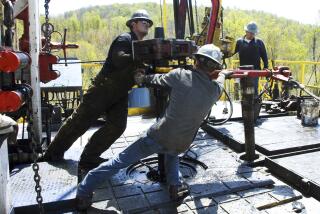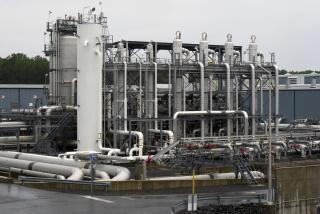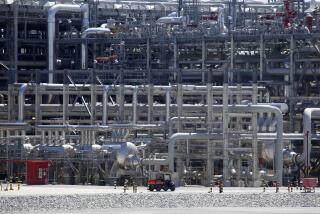U.S. energy boom may signal a new export era
In a Louisiana swamp several miles upriver from the Gulf of Mexico, about 3,000 construction workers are building a massive industrial facility to liquefy natural gas, preparing for a new era when the U.S. will begin exporting energy around the globe.
The $12-billion project is one of the largest single industrial investments in the nation, part of a massive transformation of the energy sector that has led to a boom in drilling, transportation and refining from coast to coast.
Five years ago, the idea of exporting U.S. gas and oil was not only unheard of, but, in the case of most U.S. crude oil, illegal. At that time, the United States was facing a future of dwindling domestic supplies and vulnerability to foreign producers. It was anxiously building facilities to import natural gas, worried about ever-higher prices and building much of its foreign policy on the need to secure energy supplies.
But U.S. energy production has boomed with the technological revolution of hydraulic fracturing, known as fracking, and the ability to tap newly accessible massive reserves. The nation surpassed Russia in 2009 as the largest producer of natural gas and is expected to zip past Saudi Arabia next year to become the largest oil producer in the world.
Now, the U.S. energy industry is pushing for a new era of exports.
The new liquefied natural gas plant under construction by Cheniere Energy Inc. along a waterway known as Sabine Pass in Louisiana is the first large-scale export facility approved in the country, expected to begin operation next year. Twenty-one other proposed plants are awaiting federal approval, 17 of which would line the Gulf Coast, with four others on the Atlantic and Pacific shores.
Although energy companies are legally free to export natural gas, they must go through a lengthy review process for building the multibillion-dollar terminals that are required to turn it into a liquid so it can be transported on ships. Crude oil, meanwhile, is largely subject to an export ban enacted in the 1970s-era energy crisis, when long lines at gas stations and soaring prices led to political pressure to save domestic resources for American consumers.
The oil and gas industry is pushing the Obama administration and Congress to legalize crude exports and speed up the process of licensing gas export terminals. Industry officials argue that the U.S. is now in a position of economic strength and national security that will be further enhanced by energy exports. Foreign markets for U.S. crude and natural gas will spur additional production, create thousands of new jobs, enable the U.S. to counter hostile foreign energy powers and generate billions of dollars in wealth, according to the American Petroleum Institute. Already, the U.S. is exporting 3 million barrels of gasoline per day.
“Some of these prohibitions or these policies are vestiges of the past,” API President Jack Gerard told reporters. “Our resource potential in this country is vast, it’s large. It’s unprecedented, even more so than any of us would have thought five or six years ago. So we need to rethink these policies, including the crude export policy.”
Every energy boom, however, has spurred ambitious investments that seemed promising at the time but produced unexpected problems and led to massive losses — and the idea of investing billions of dollars in gas export terminals with the idea of making billions more may carry the same risks, other experts say.
Frank Wolak, a Stanford University energy expert, said it would require billions of dollars and many years to obtain government permits for gas export terminals, giving foreign nations plenty of time to develop their own shale gas extraction programs using U.S. technology. By the time the United States is ready to export large amounts of gas, the demand could dry up, he said.
“Ten years ago, we thought we were facing a gas shortage and we built all of these facilities to import natural gas,” he said. “Now they are all sitting idle.”
Other experts worry that the U.S. will probably need all of the natural gas it will produce over the next few decades, as utilities switch from coal under pressure by environmental regulators and as the nation’s fleet of heavy trucks adopts natural gas engines.
“It may turn out that all that gas that people want to export may be necessary to fill the hole in our electricity generation when you take coal out of the mix,” said Daniel Kish, senior vice president at the Institute for Energy Research.
Kish estimates that if environmentalists are successful in significantly reducing the amount of coal used to generate electricity, the U.S. could require an additional 10 trillion cubic feet of natural gas per year, which could be provided largely by tapping the expected growth of shale gas extracted by fracking and horizontal drilling. It doesn’t appear that the U.S. will dramatically expand nuclear or hydro power plants, he said.
Cheniere, however, projects that global demand for imports of liquefied natural gas, or LNG, will double by 2030. The company says the structure of its deals would ensure that the project will remain financially profitable.
And there are substantial political, legal and technical impediments to re-creating a fracking boom in China, India or Argentina, all of which have large shale gas deposits, gas industry leaders argue. (Fracking is a process in which oil and gas are extracted from rock by injecting high-pressure mixtures of water, gravel or sand and chemicals.)
Crude exports are even more politically fraught, though they may be less economically risky.
Oil output will continue to grow through at least 2019, according to Energy Department projections. An even larger expansion could occur if drilling is permitted in many prime spots currently off limits, including California’s massive Monterey Shale formation.
But under the most likely scenarios, the U.S. will remain a net importer of oil. So many consumers remember lining up for gasoline during the oil embargoes of the 1970s that politicians have been reluctant to suggest that the U.S. send its oil abroad, other than the limited amount already exported out of Alaska. Though there is suddenly widespread discussion of lifting the export ban, not a single piece of legislation has been introduced.
Why export oil when the nation is still importing even more of it? Moving oil around the nation is expensive, and in some cases the U.S. lacks the type of refineries best suited to refine the new light crudes produced in North Dakota. It could sell that high-priced crude to foreign refiners and import more heavy crude at up to $30 per barrel less, which U.S. refineries are best at cracking, according to Wolak.
It would result in an economic windfall not only for the energy industry but governments that take a share of the profits, advocates say. Even the controversial Keystone XL pipeline, which would transport Canadian and North Dakota crude to the Gulf Coast, could wind up playing a key role in exporting North American energy.
Industry officials say oil and gas exports have the ability to turn the nation into an “energy superpower,” ready to exert new influence internationally. In the wake of the crisis in the Ukraine, three Eastern European nations have lodged formal requests for the U.S. to speed up its ability to export natural gas to counter Russia’s role as a supplier. Ukraine itself has explored the idea of importing LNG to remove its dependence on Moscow.
The most often-heard domestic argument in favor of U.S. exports involves job growth, and the Sabine Pass project is a good example of the local impact such projects may have. Industry officials predict that growing natural gas production alone will create 665,000 direct and indirect jobs by 2035.
But experts who study the industry question such exuberance. The entire oil and gas sector is a tiny part of the U.S. economy, accounting for about 600,000 direct jobs out of 132 million. Even more importantly, the sector is not forecast to grow at all as a proportion of the economy, even while gas and oil production soars, according to official projections by the Energy Information Administration, a part of the Energy Department.
“Many people think it will be a game changer in the U.S. economy,” said Kay Smith, the Energy Information Administration’s lead economist who studies the oil and gas sector. “But I don’t see it.”
More to Read
Sign up for Essential California
The most important California stories and recommendations in your inbox every morning.
You may occasionally receive promotional content from the Los Angeles Times.











